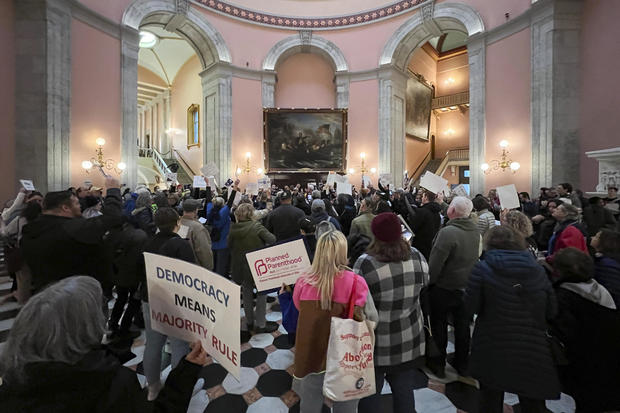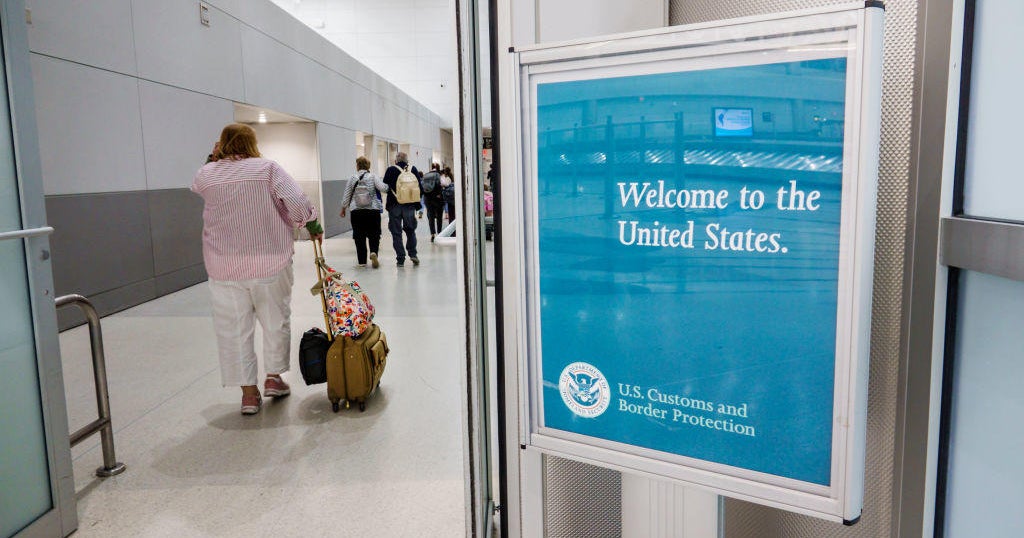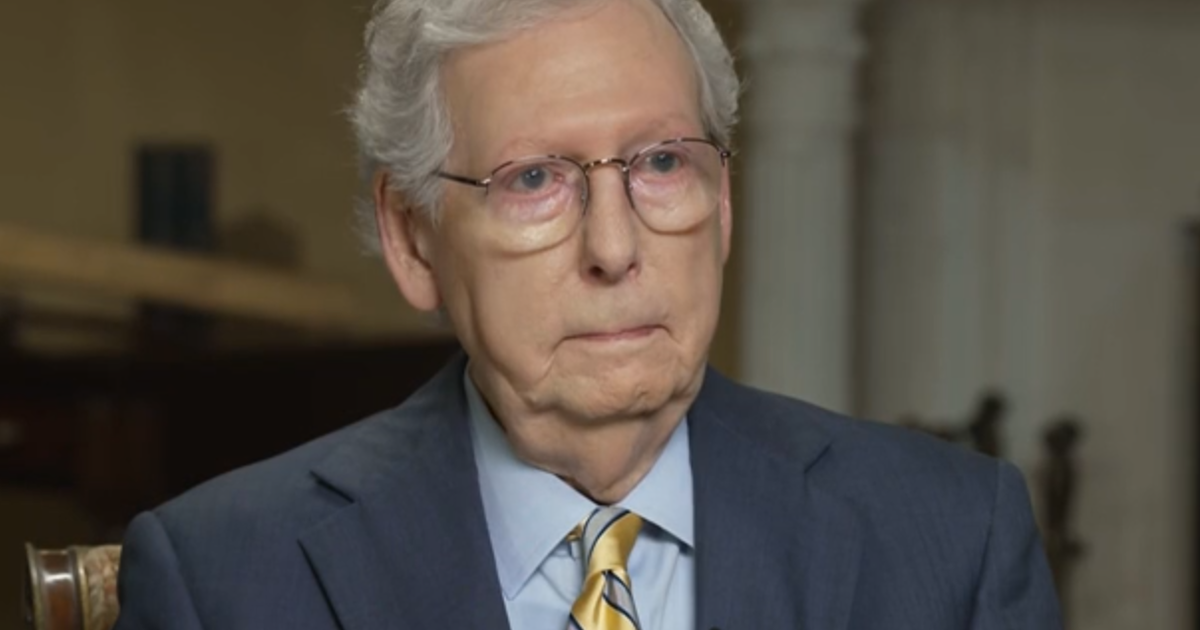What the rejection of Ohio's Issue 1 could mean for abortion rights in the state
Washington — In a closely watched special election, Ohio voters rejected Issue 1, which could have a major impact on whether the right to an abortion becomes enshrined in the state constitution later this fall.
The defeated measure would have made it more difficult to amend the Ohio Consitution by requiring proposed amendments to receive support from 60% of voters, rather than the simple majority currently needed.
The question of whether to raise the threshold landed on the ballot after Ohio's GOP-led General Assembly approved a joint resolution in May to send the matter to voters. But the effort to set the supermajority benchmark also came as abortion rights supporters were mounting their own campaign to put reproductive rights directly on the ballot in November.
The two ballot measures — Tuesday's question on raising the standards to pass a constitutional amendment, and November's proposal on enshrining abortion rights in the state constitution — have garnered immense interest from voters and stakeholders nationwide. Ohio is the only state with abortion access on the ballot this year.
Early voter turnout in Ohio had surged for Tuesday's special election, with nearly 700,000 people voting by mail or in-person during the early-voting period. By comparison, 288,700 people voted early for the May 2022 primary election, according to the Associated Press.
Here's what to know about Issue 1, the ballot measure that was at the center of Ohio's special election.
What is Issue 1 in Ohio?
State Issue 1 was a proposed constitutional amendment that would have elevated the standards to place a citizen-initiated constitutional amendment on the ballot and pass it.
Proposed by a joint resolution of the Ohio legislature, the measure would have required that any proposed constitutional amendment receive approval from at least 60% of voters.
The amendment would also have required any initiative petition filed after Jan. 1 seeking to change the Ohio Constitution to be signed by at least 5% of the electors of each of Ohio's 88 counties.
The plan needed a majority of "yes" votes to pass. Had it met that bar, the supermajority threshold would have taken effect immediately.
A summary of the argument in favor of Issue 1 prepared by two Republican lawmakers stated that a "yes" vote "protects our Constitution from deep-pocketed, out-of-state interests. By passing Issue 1, the People would have ensured constitutional changes are widely accepted and declare that Ohio's Constitution is not for sale."
"Currently, special interests target Ohio, seeking to inject their own personal views and objectives into our state's most sacred document. Why? Because Ohio is one of the few states that allow these interests to directly enshrine their social preferences and corporate motives into the Constitution at the same threshold as everyday laws," they wrote. "Common sense tells us that this should not be the case."
In a summary of the argument against Issue 1, a group of Democratic lawmakers said the amendment "would destroy citizen-driven ballot initiatives as we know them, upending our right to make decisions that directly impact our lives. It takes away our freedom by undermining the sacred principle of 'one person, one vote' and destroys majority rule in Ohio."
"[H]ere we are, voting in August on just one question: should Ohio permanently abolish the basic constitutional right of majority rule?" the state lawmakers said, referencing a bill approved by the Ohio legislature in December that eliminated most August special elections. "Special interests and corrupt politicians say yes. They don't like voters making decisions, so they're trying to rewrite the rules to get what they want: even more power."
What does the Issue 1 polling say?
Three polls conducted prior to the vote examined public support for Issue 1 and found that less than half of Ohioans favored the effort to increase the threshold to change the state constitution.
A Scripps News/YouGov poll conducted in June found that 38% of Ohio adults agreed with the proposal, while an Ohio Northern University from mid-July found that 42.4% of registered voters backed the plan. A third poll from USA Today Network/Suffolk University released last month found 26.2% of likely voters support Issue 1.
How did Issue 1 get on the ballot?
A joint resolution to require a 60%-vote to approve any constitutional amendment cleared both chambers of Ohio's Republican-led General Assembly this spring. The state's constitution allows the state legislature to propose amendments to it and, if approved by three-fifths of each house, the proposals then go before voters for their approval or rejection.
The GOP-controlled state House and Senate easily approved the measures, but not without pushback from protesters who descended on the statehouse. Demonstrators opposed the effort to do away with the simple-majority threshold — 50%, plus one vote — for constitutional amendments, which has been in place since 1912.
Who was behind the drive to change the threshold for constitutional amendments?
A recent CBS News investigation found that the attempt in Ohio to make it more difficult to change the state constitution is one aspect of a nationwide campaign heavily backed by Richard Uihlein, a shipping supplies magnate and GOP megadonor.
The investigation found Uihlein donated $1.1 million in April to a political committee that pushed Ohio lawmakers to clear the resolution to raise the standards to pass a constitutional amendment.
Uihlein was also the top contributor to Protect Our Constitution, the main organization backing Issue 1. He donated $4 million to the group, out of the $4.85 million it raised in total.
The main organization opposing Issue 1, One Person, One Vote, raised $14.8 million. Roughly $2.5 million of its funding came from the Sixteen Thirty Fund, a Washington, D.C.-based group that supports progressive causes.
How would Issue 1 have impacted the Ohio abortion amendment?
Abortion-rights advocates saw success in all six states where the issue was on the ballot in 2022, after the Supreme Court overturned Roe v. Wade. Ballot measures protecting abortion rights were approved in three states, while proposals restricting abortion access were defeated in three states.
Ohio became the next battleground in the campaign to enshrine reproductive rights in state constitutions.
The proposed amendment, called "The Right to Reproductive Freedom with Protections for Health and Safety," qualified for the November general election ballot in July. Ohio Secretary of State Frank LaRose said the group Ohioans for Reproductive Freedom submitted nearly 496,000 valid signatures — exceeding the roughly 413,000 required.
The measure provides that every individual has the right to make their own reproductive decisions, including on contraception and abortion, and prohibits the state from prohibiting or interfering with the "voluntary exercise of this right."
The measure would allow the state to prohibit abortion after fetal viability, which it defines as "the point in a pregnancy when, in the professional judgment of the pregnant patient's treating physician, the fetus has a significant likelihood of survival outside the uterus with reasonable measures."
Currently, the abortion rights ballot measure would need a simple majority to pass. But if voters approve Issue 1, it will be subject to the new 60% standard.
A July USA Today Network/Suffolk University poll showed 58% of likely voters in Ohio support the proposed abortion rights amendment — significant support that would still fall short of the supermajority bar sought in Issue 1.
— Caitlin Huey-Burns and Michael Kaplan contributed reporting.





